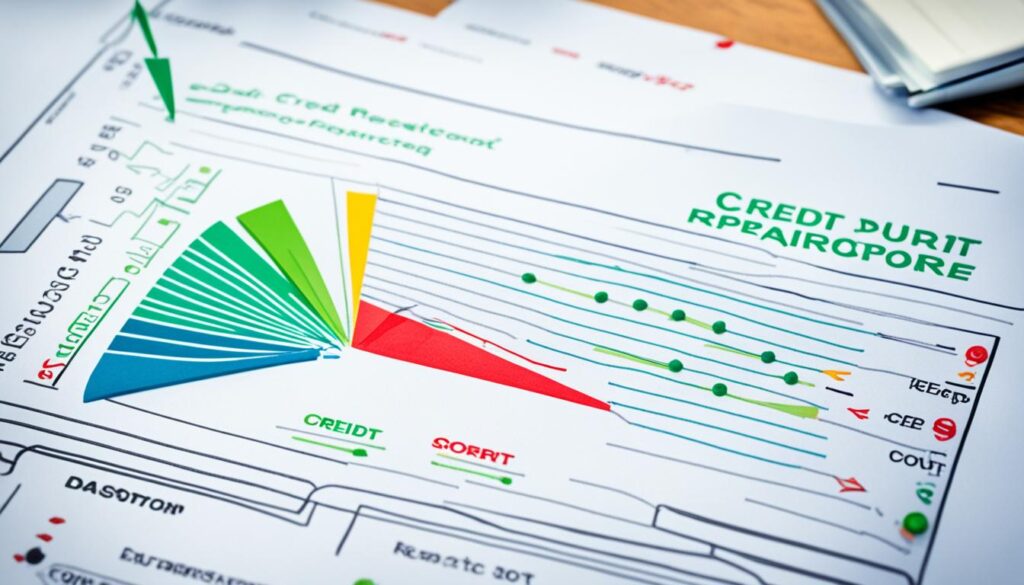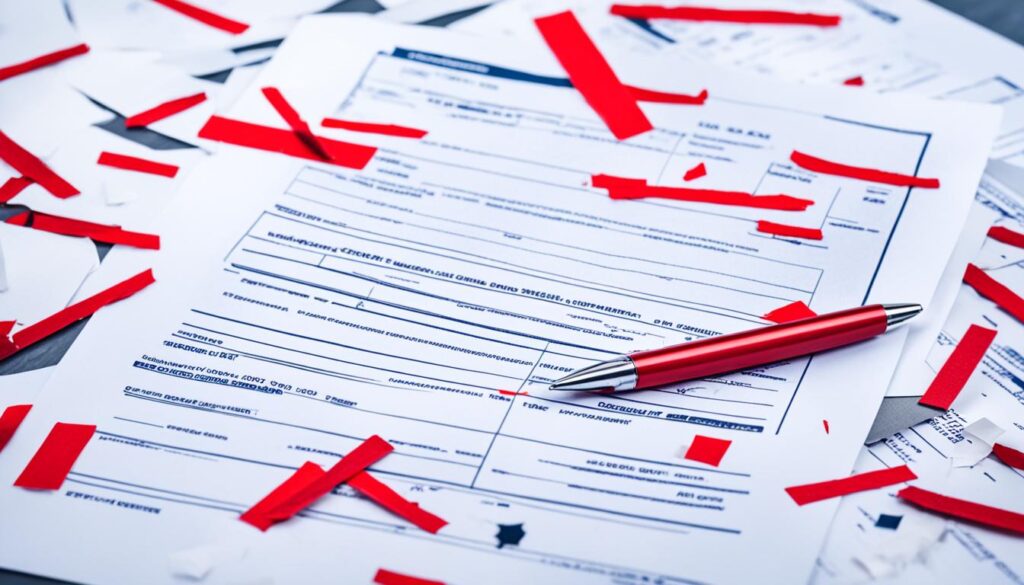Maintaining a healthy credit score is crucial for your financial well-being, as it impacts your ability to secure loans, mortgages, and even employment opportunities. However, errors and inaccuracies on your credit report can hinder your creditworthiness, making it necessary to take proactive steps to fix credit score issues. One of the most effective strategies is to leverage credit dispute letters, a powerful tool in your arsenal to challenge and correct inaccuracies on your credit report.
This comprehensive guide will walk you through the process of using credit dispute letters to fix your credit score and boost your financial standing. From understanding the different types of credit dispute letters to navigating the credit bureau dispute process, you’ll learn the proven strategies to remove negative items, validate debts, and ultimately rebuild your creditworthiness.
Key Takeaways
- Discover the power of credit dispute letters to fix your credit score and improve your financial standing.
- Learn the various types of credit dispute letters and when to use them effectively.
- Understand the importance of monitoring your credit reports and identifying credit report errors.
- Gain insights on the step-by-step process of preparing and drafting an effective credit dispute letter.
- Explore strategies for dealing with credit bureau responses and maintaining accurate credit reports.
Understanding Credit Dispute Letters
Protecting your credit score is crucial in today’s financial landscape. One powerful tool at your disposal is the humble credit dispute letter. These letters allow you to rectify inaccuracies in your credit reports, ensuring your credit file accurately reflects your financial history.
Types of Credit Dispute Letters
There are several distinct types of credit dispute letters, each targeting specific sections of the Fair Credit Reporting Act (FCRA). Understanding the purpose and features of these letters can help you effectively challenge and correct errors in your credit report.
- General Dispute Letter: This letter is a versatile option, allowing you to dispute a wide range of credit report errors, from incorrect account information to fraudulent activities.
- 609 Credit Dispute Letter: Named after the relevant FCRA section, this letter focuses on disputing the accuracy and completeness of information in your credit file.
- 611 Credit Dispute Letter: Invoking FCRA Section 611, this letter is used to dispute the investigation process undertaken by credit bureaus when addressing your initial credit dispute.
- 623 Credit Dispute Letter: Leveraging FCRA Section 623, this letter is employed when a furnisher (a company reporting information to the credit bureaus) fails to update or correct inaccurate information in your credit report.
By strategically utilizing these various credit dispute letter formats, you can effectively challenge and rectify a wide range of credit report errors, ultimately improving your credit score and financial standing
.
| Type of Credit Dispute Letter | FCRA Section | Key Purpose |
|---|---|---|
| General Dispute Letter | N/A | Dispute a wide range of credit report errors |
| 609 Credit Dispute Letter | FCRA Section 609 | Dispute the accuracy and completeness of information in your credit file |
| 611 Credit Dispute Letter | FCRA Section 611 | Dispute the investigation process undertaken by credit bureaus |
| 623 Credit Dispute Letter | FCRA Section 623 | Dispute a furnisher’s failure to update or correct inaccurate information |
Importance of Monitoring Credit Reports
Regularly monitoring your credit reports is a crucial step in maintaining healthy credit profiles. Credit report errors, even minor ones, can significantly impact your credit score and creditworthiness, making it essential to proactively identify and address any discrepancies. By closely monitoring credit reports, you can protect your financial reputation and secure favorable lending terms.
Vigilant credit report monitoring serves several important purposes:
- Identifies credit report errors that could negatively affect your credit score and overall creditworthiness assessment.
- Allows you to promptly dispute and correct any inaccuracies, ensuring your credit profile accurately reflects your financial history.
- Helps you stay informed about changes to your credit data, empowering you to make informed financial decisions.
- Enables you to detect signs of identity theft or fraudulent activity, safeguarding your financial well-being.
By making monitoring credit reports a regular practice, you can proactively protect your credit standing and maintain a healthy financial profile essential for securing favorable lending terms and opportunities.

| Benefit | Description |
|---|---|
| Identify Errors | Regularly reviewing your credit reports helps you spot and correct any inaccuracies that could impact your credit score. |
| Detect Fraud | Monitoring your reports allows you to promptly detect signs of identity theft or unauthorized activities, safeguarding your financial well-being. |
| Improve Creditworthiness | Maintaining accurate and healthy credit profiles enhances your creditworthiness assessment, leading to better lending terms and opportunities. |
By making monitoring credit reports a consistent practice, you can take proactive steps to protect your credit, mitigate risks, and position yourself for financial success.
Identifying Credit Report Errors
Maintaining an accurate credit report is crucial for your financial well-being, but errors can sometimes creep in. It’s essential to regularly review your credit report to identify any discrepancies or inaccuracies that could impact your credit score and ability to access credit.
Credit report errors can take various forms, including:
- Incorrect account information, such as wrongly reported payment histories or account balances
- Fraudulent accounts that don’t belong to you
- Outdated or erroneous personal information, like your name, address, or date of birth
The impact of these errors can be significant, potentially lowering your credit score and hindering your access to favorable financing options, such as loans, credit cards, or mortgages. It’s critical to address these issues promptly to maintain a strong financial profile and avoid unnecessary obstacles in your credit-related endeavors.
| Type of Credit Report Error | Potential Impact |
|---|---|
| Incorrect account information | Lower credit score, difficulty securing credit |
| Fraudulent accounts | Identity theft, damaged credit history |
| Outdated personal information | Inaccurate credit profile, potential delays in credit applications |
By actively identifying credit report errors, you can take the necessary steps to dispute and correct these issues, ultimately protecting your credit score and maintaining a strong financial foundation.

Preparing to Write a Credit Dispute Letter
Before drafting a credit dispute letter, it’s crucial to take the necessary steps to thoroughly review your credit report, identify the specific errors, and gather supporting documentation. Familiarizing yourself with your rights under the Fair Credit Reporting Act (FCRA) is also essential to ensure you follow the proper procedures in disputing inaccuracies. This preparatory phase lays the groundwork for creating an effective and well-supported credit dispute letter.
Steps Before Drafting the Letter
- Obtain your credit report: Start by requesting a copy of your credit report from each of the three major credit bureaus: Experian, Equifax, and TransUnion. Carefully review each report to identify any inaccuracies or errors.
- Gather supporting documents: Collect any documentation that supports your claim of inaccurate information on your credit report, such as receipts, statements, or correspondence with creditors.
- Understand your FCRA rights: Familiarize yourself with the FCRA and the protections it provides, ensuring you are aware of your rights and the proper steps to dispute credit report errors.
- Review the credit report review process: Thoroughly understand the credit report review process and the timelines involved, so you can effectively navigate the dispute process and follow up on your claim.
By taking these important preparatory steps, you’ll be well-equipped to prepare a credit dispute letter that is supported by evidence and aligns with your FCRA rights. This foundation will increase the likelihood of a successful resolution to your credit report errors.

Writing an Effective Credit Dispute Letter
Crafting a persuasive and comprehensive credit dispute letter is a crucial step in addressing inaccuracies on your credit report. By including essential details such as your personal information, the specific errors you are disputing, the correct information, and supporting documentation, you can increase the likelihood of a favorable outcome from the credit bureaus.
Key Elements to Include
To write an effective credit dispute letter, be sure to incorporate the following key elements:
- Your Personal Information: Clearly state your full name, address, and other relevant personal details to ensure the credit bureau can accurately identify your credit file.
- Specific Errors: Clearly identify the specific inaccuracies or errors on your credit report, providing as much detail as possible to support your claims.
- Correct Information: Provide the accurate information that should be reported on your credit file, along with any supporting documentation to substantiate the corrections.
- FCRA Compliance: Ensure your letter aligns with the requirements set forth in the Fair Credit Reporting Act (FCRA) to demonstrate your understanding of your rights and the credit bureau’s obligations.
- Credit Bureau Response: Request that the credit bureau investigate the disputed items and provide you with a written response regarding the outcome of their investigation.
By including these key elements in your credit dispute letter, you can effectively prompt a thorough investigation and correction of the reported inaccuracies, ultimately helping to write effective credit dispute letter and improve your FCRA compliance with the credit bureau response.

fix credit score with dispute letters
Unlocking the power of credit dispute letters can be a game-changer in your quest to fix your credit score and improve your overall financial standing. By proactively challenging and correcting inaccuracies in your credit reports, you can remove negative items, validate debts, and rebuild your creditworthiness.
The process of fixing your credit score with dispute letters is a strategic and effective approach that can lead to a higher credit score and better access to credit, financing, and business opportunities. Let’s explore how this method can transform your financial landscape.
Uncover Credit Report Errors
The first step in leveraging dispute letters is to thoroughly review your credit reports for any errors or inaccuracies. This could include:
- Incorrect account information
- Wrongly reported late payments or delinquencies
- Identity theft-related issues
- Outdated or unverified information
By identifying thesecredit report errors, you can take the necessary steps to initiate a dispute and have them corrected, leading to a potentialcredit score improvement.
Craft Effective Dispute Letters
Once you’ve identified the inaccuracies in your credit file, it’s time to draft your dispute letters. These letters should be concise, well-documented, and firmly yet politely request the credit bureaus to investigate and correct the credit report accuracy issues.
By following a structured approach and including essential details, such as supporting documentation and a clear explanation of the errors, your dispute letters can effectively navigate the credit dispute process and drive the desired outcomes.
Persistence and patience are key when it comes to fixing your credit score with dispute letters. The credit bureaus are required to investigate and respond to your disputes, but the process may take time. Staying organized, tracking your progress, and following up as necessary can help ensure a successful resolution.
“Dispute letters are a powerful tool in your arsenal to reclaim control over your credit and financial future.”
By utilizing credit dispute letters effectively, you can take a proactive approach to credit score improvement and credit report accuracy. This strategic step can open doors to better financial opportunities, greater access to credit, and a more secure financial footing.
Dealing with Credit Bureau Responses
When you submit a credit dispute letter, the credit bureaus are required to investigate the issue and provide you with the results. Understanding how credit bureaus respond to your disputes is crucial for effectively navigating the dispute resolution process and ensuring compliance with the Fair Credit Reporting Act (FCRA).
After you file a dispute, the credit bureaus have a legal obligation to investigate the matter within 30 days. They must either verify the accuracy of the disputed information or remove it from your credit report if they cannot confirm its validity. The bureaus must then provide you with the results of their investigation, which you can use to track the progress of your dispute resolution.
If the credit bureaus verify the disputed information as accurate, you have the right to submit a statement of dispute to be included in your credit report. This statement can provide additional context and explain your side of the story. Additionally, you can request that the credit bureaus provide you with copies of any documents they relied upon in their investigation.
To ensure a successful dispute resolution, it’s important to follow up with the credit bureaus and monitor the status of your dispute. Keep meticulous records of all correspondence and maintain a timeline of the process. By staying proactive and understanding your rights under the FCRA, you can effectively navigate the credit bureau response and achieve the desired outcome for your credit dispute.
| Key Steps in Dealing with Credit Bureau Responses |
|---|
|
“Staying vigilant and proactive in the credit dispute process is key to ensuring your credit report accurately reflects your financial history.”
Hiring Professional Credit Repair Services
If you have a complex credit history or a significant number of errors to dispute, it may be beneficial to consider hiring professional credit repair services to handle the process on your behalf. These specialized services can help you navigate the intricacies of credit disputes, draft effective credit dispute letters, and follow up with credit bureaus to ensure the timely resolution of your credit issues.
When it comes to credit repair companies, the expertise and experience they bring to the table can be invaluable. They understand the complexities of credit histories and can develop tailored strategies to address your specific credit challenges. By enlisting their assistance, you can take the guesswork out of the credit dispute process and increase your chances of successfully improving your credit score.
However, it’s important to do your research and choose a reputable professional credit repair service that has a proven track record of success. Look for a company that is transparent about its fees, offers clear communication, and provides regular updates on the progress of your case. This will ensure that you get the most value from your investment and that your credit concerns are addressed effectively.
| Benefits of Hiring Professional Credit Repair Services | Considerations When Choosing a Credit Repair Company |
|---|---|
|
|
By leveraging the expertise of a reputable credit repair company, you can take a proactive approach to addressing your credit concerns and work towards achieving your financial goals.
Maintaining Accurate Credit Reports
Preserving a strong financial reputation and securing favorable lending terms hinges on the maintenance of accurate credit reports. Establishing a routine of regular credit monitoring and proactive report management is essential for long-term financial health.
One key strategy is to enroll in a credit monitoring service. These services offer valuable insights, alerting you to any changes or errors within your credit file. By promptly addressing any discrepancies, you can ensure your credit report accurately reflects your creditworthiness.
Beyond monitoring, taking an active role in managing your credit file is crucial. Regularly review your credit reports and promptly address any new errors or changes. This may involve disputing inaccuracies with the credit bureaus, providing updated personal information, or ensuring that positive credit history is accurately reported.
| Credit Monitoring Service | Key Benefits |
|---|---|
| Experian | – Real-time credit report monitoring – Fraud detection and identity theft protection – FICO score tracking |
| TransUnion | – Daily credit report updates – Credit score tracking – Dark web monitoring |
| Equifax | – Comprehensive credit report monitoring – Credit report dispute assistance – Identity theft insurance |
By maintaining accurate credit reports, credit monitoring, and credit file management, you can safeguard your financial reputation and access the most favorable lending terms. Proactive credit report maintenance is a crucial step in achieving and preserving your desired credit score.
“Regularly reviewing and updating your credit file is the best way to ensure your financial record accurately reflects your creditworthiness.”
Conclusion
In the end, leveraging strategic credit dispute letters is a powerful approach to enhance your credit score and fortify your financial standing. By understanding the diverse types of credit dispute letters and effectively identifying and addressing errors in your credit reports, you can reclaim control over your credit profile and unlock better credit-related opportunities for your business. Remain vigilant in monitoring your credit reports and maintain accurate records to ensure your creditworthiness is precisely reflected.
Consistently employing credit dispute letters, alongside diligent credit report monitoring, is a comprehensive credit repair strategy that can significantly improve your credit score improvement, credit report accuracy, and overall financial health. Embrace this proactive approach to credit management and unlock a brighter, more financially secure future for your business.
Remember, your credit is a valuable asset that requires continuous care and attention. By mastering the art of credit dispute letters and staying informed about the latest credit repair strategies, you can navigate the financial landscape with confidence, positioning your business for long-term success.
FAQ
What are the different types of credit dispute letters?
Why is it important to regularly monitor your credit reports?
What are the common types of credit report errors that businesses may encounter?
What steps should you take before drafting a credit dispute letter?
What are the key elements to include in an effective credit dispute letter?
How can credit dispute letters help fix your credit score?
How should you respond to credit bureau responses to your dispute letters?
When should you consider hiring professional credit repair services?
What strategies can you use to maintain accurate credit reports?
Source Links
- How do I dispute an error on my credit report? | Consumer Financial Protection Bureau – https://www.consumerfinance.gov/ask-cfpb/how-do-i-dispute-an-error-on-my-credit-report-en-314/
- Credit Dispute Letter: Types, How to dispute it & Samples – https://www.highradius.com/resources/Blog/what-is-credit-dispute-letter-and-how-to-dispute-credit-report/
- 5 Tips To Write Effective Credit Repair Letters – https://www.turbodebt.com/credit-repair/letters

